Introduction
- Splinter group of Islamic State stages attacks across Paris;
- The attack considered the deadliest since World War II;
- Islamic state had carried other attacks in the country;
- Law enforcement agencies were unprepared;
- The intelligence agencies were blamed for the attack;
- Poor communication among the security apparatus contributed to the attacks.
On November 13, 2015, a splinter group of the Islamic State from Iraq staged a series of terror attacks in France’s capital killing 131 people and injuring at least 400 others. Security experts and historians consider this assault one of the most deadly to have happened in the country since World War II (Cruickshank). In the past, the Islamic State had carried out numerous attacks across Paris like the infamous Charlie Hebdo. However, the one that took place on November 13 would be regarded the most horrible due to the number of casualties and the fact that it caught law enforcement agencies flatfooted. A parliamentary commission established to investigate the factors that contributed to these attacks cited failure by the intelligence agencies as the main problem. Poor communication between security organs made it hard to supervise the activities of the terrorists, bearing in mind that some had already been designated as a threat to the nation. This paper will give a historical account of the November 13 attacks and give recommendations on what could have been done to prevent the killings.
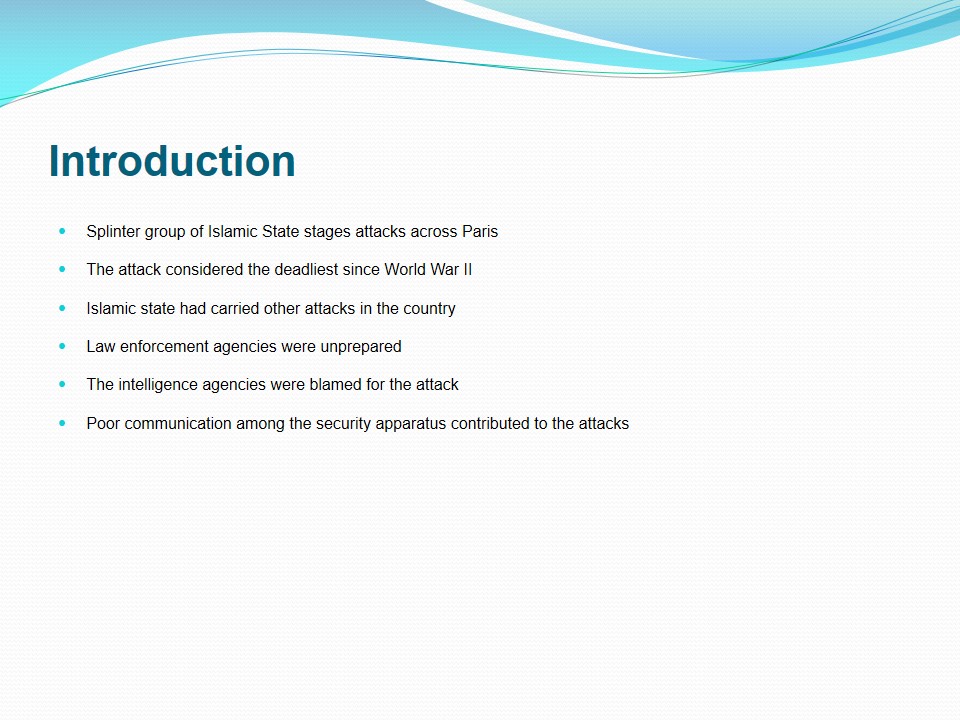
An Account of the Attacks
- On November 13, 2015, terrorists hired three cars to use for attacks;
- Some Minutes before 9.00 pm three terrorists arrived at the stadium;
- France and Germany teams were having a friendly football match;
- Stadium had at least 80,000 spectators, including the president of France;
- Terrorists tried to enter into the stadium;
- Security guard prevented them due to lack of tickets;
- One of the attackers concealed an explosive vest with a Bayern Munich jersey;
- One terrorists tried to access stadium several times;
- At 9.20 am, terrorist exploded his vest outside the stadium;
- Police found forged travel documents from the dead radical;
- Five minutes later, another team attacks revelers in two cafes;
- They stopped they stopped their vehicle and started shooting at people indiscriminately;
- At 9.30 pm another explosion was reported near the stadium;
- Another attacker blew up himself but there were no casualties;
- Twenty minutes later, another terrorist explodes his vest near a McDonald’s eatery;
- At 9.32 pm, terrorists open fire on customers at Bonne Biere and Casa Nostra cafes;
- Four minutes later, they attack people at La Belle Equipe restaurant;
- At 9.42 pm, one of terrorists blew up himself in a terrace;
- At 9.42 pm, three terrorists arrive at a concert hall;
- One of them sent a text to their leader;
- Police discovered a phone dumped in a garbage can;
- In the concert hall, the attackers carried out coordinated assault;
- They had sufficient knowledge of the hall;
- One of the attackers guarded the emergency exit.
According to investigations carried out after the killings, on this fateful night, the terrorists hired three cars which they used to carry out attacks in different parts of the city. Some minutes before 9.00 pm, one of the cars, a Renault Clio with three occupants pulled up in the parking lot of the national stadium where France and Germany national teams were expected to have a friendly football match (Cruickshank). The arena was packed with at least 80,000 spectators, including President Francois Hollande (Cruickshank). The three men came out of the car and made their way to the stadium’s foyer. However, the security personnel at the gate could not let them in because they lacked tickets.
Eye witnesses narrated that one of the attackers was wearing Bayern Munich jersey, which he used to conceal an explosive vest (Cruickshank). A security officer at one of the gates claimed that one of the terrorists tried to make his way into the stadium on several occasions without succeeding. At 9.20 am, the suicide bomber (an Iraqi citizen) realized that they were getting late and decided to detonate himself outside the gate, killing one person (Cruickshank). Police found a forged Syrian passport bearing the name Ahmad al Mohammad close to a mutilated body of the attacker. Five minutes after the blast, another group of terrorists opened fire on customers of Carillon and Cambodge hotels killing 13 people. Bystanders claimed that three terrorists stopped their car in the middle of the road, came out, and started shooting indiscriminately at motorists and café patrons.
At around 9.30pm, another explosion was reported in the stadium. A second attacker blew up himself near Gate H, but there were no people around. Twenty minutes after this attack, the third suicide bomber exploded his vest close to a McDonald’s bistro, injuring at least 50 people (Cruickshank). The group that opened fire at Carillon and Cambodge cafes got back into their car and drove to another location. At 9.32 pm, the same team was reported to attack customers at the Bonne Biere and Casa Nostra restaurants, killing five people. They again drove and four minutes later attacked customers of La Belle Equipe hotel, killing 19 revelers (Cruickshank). The attackers spend off and 8 minutes after the shooting, one of them was seen walking into a covered terrace before he blew up himself.
At around 9.42 pm, three terrorists; Mohamed-Aggad, Samy Amimour, and Ismael Omar Mostefai drove to a concert hall in Bataclan. One of the terrorists used his phone to send a message to their leader informing him that they were about to start the attacks (Cruickshank). Police later found the phone dumped in a garbage can near the scene, which helped them to identify the masterminds of these attacks. Inside the Bataclan concert hall, the terrorists carried out synchronized attacks to ensure that they killed as many people as possible. They appeared to have adequate knowledge of the architectural design of the hall, making it difficult for their victims to hide or escape. One of the terrorists even waited for people at the emergency exit to prevent them from going out.
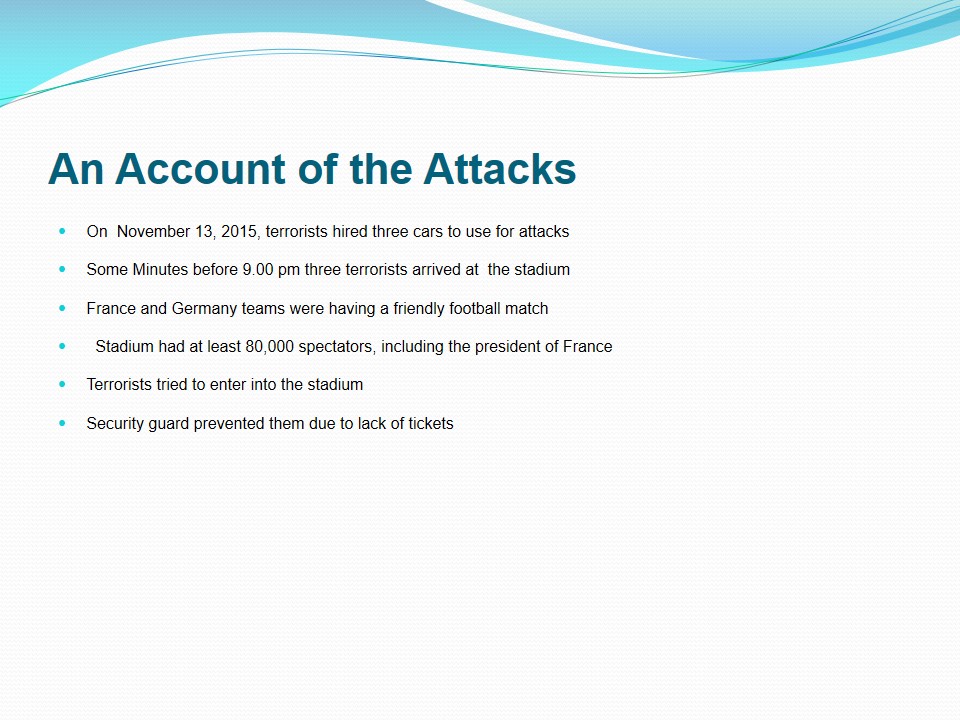
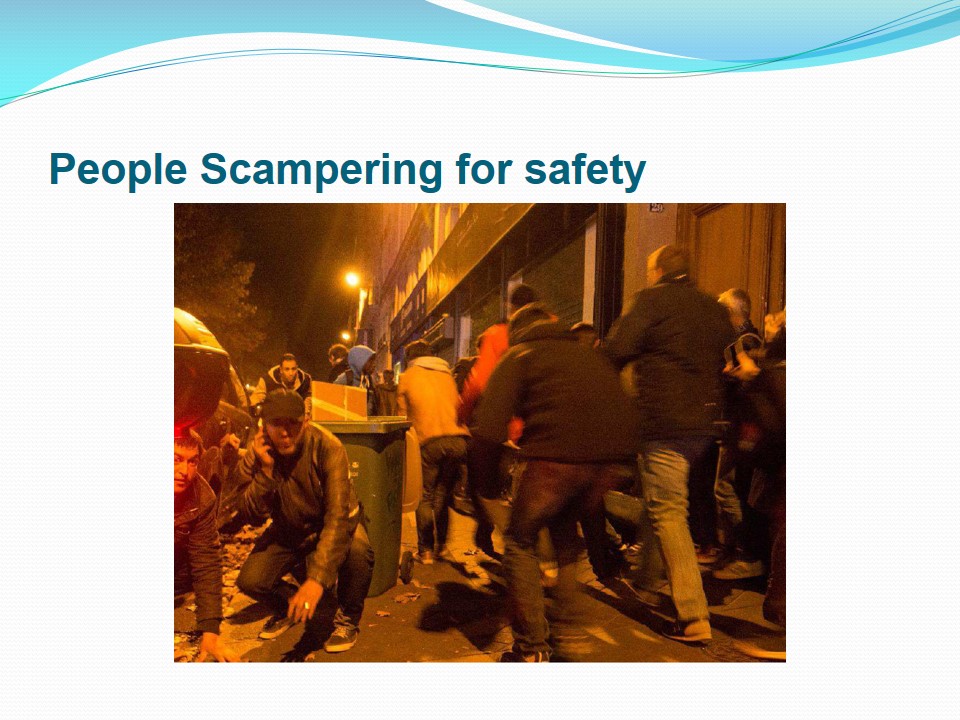
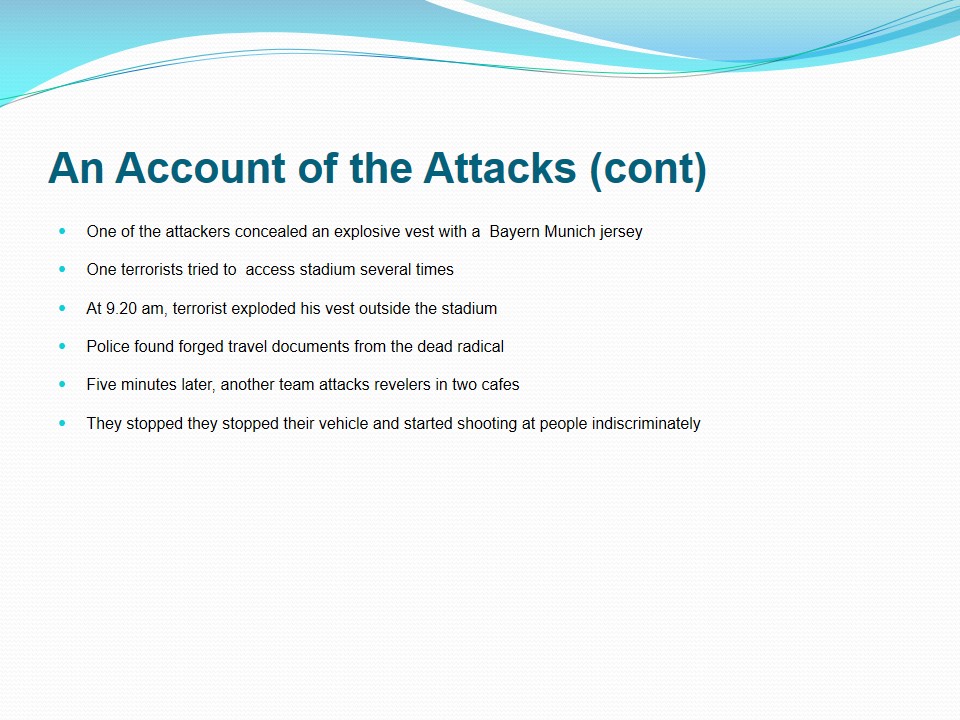
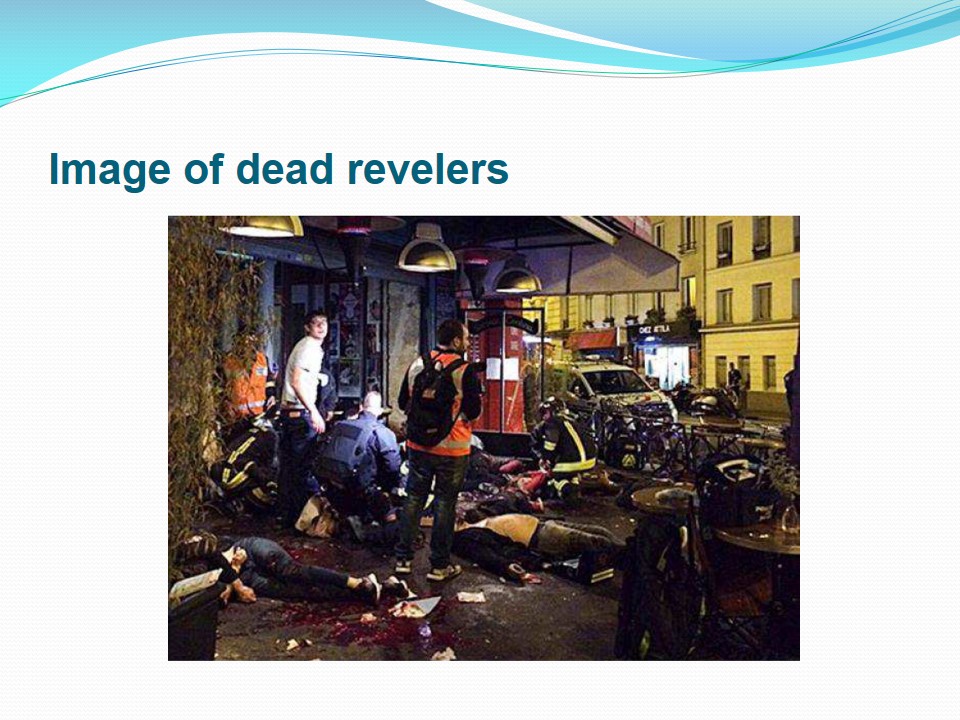
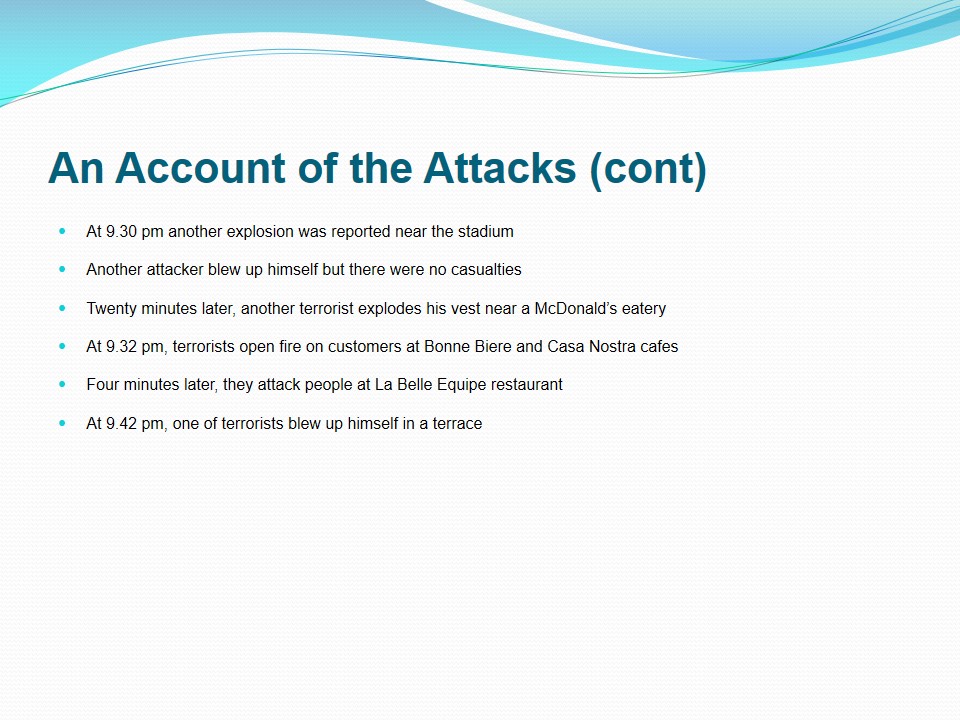
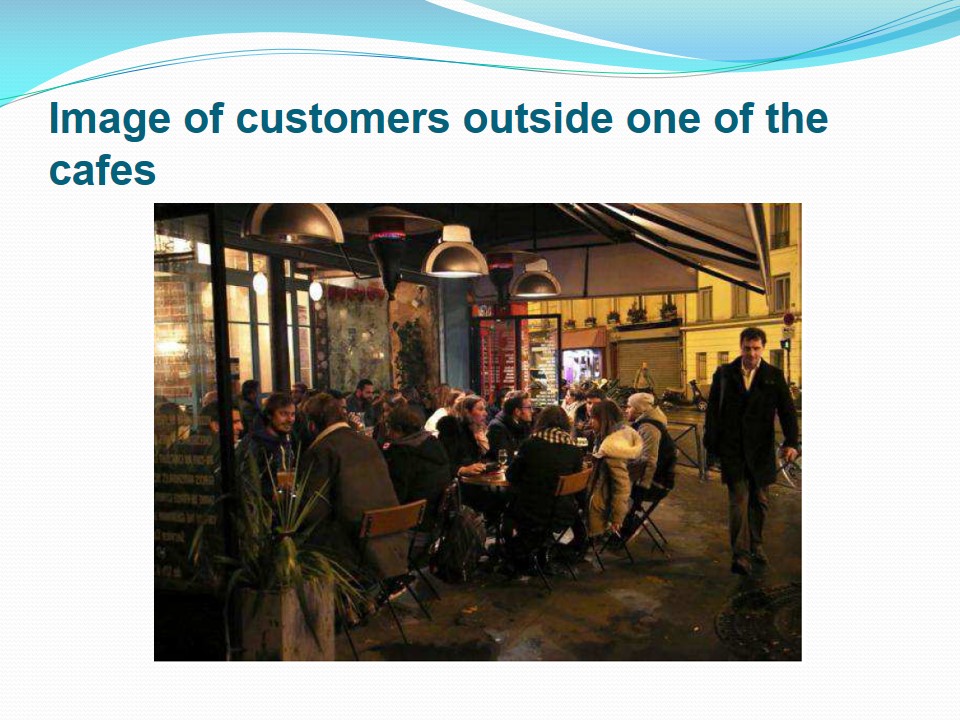
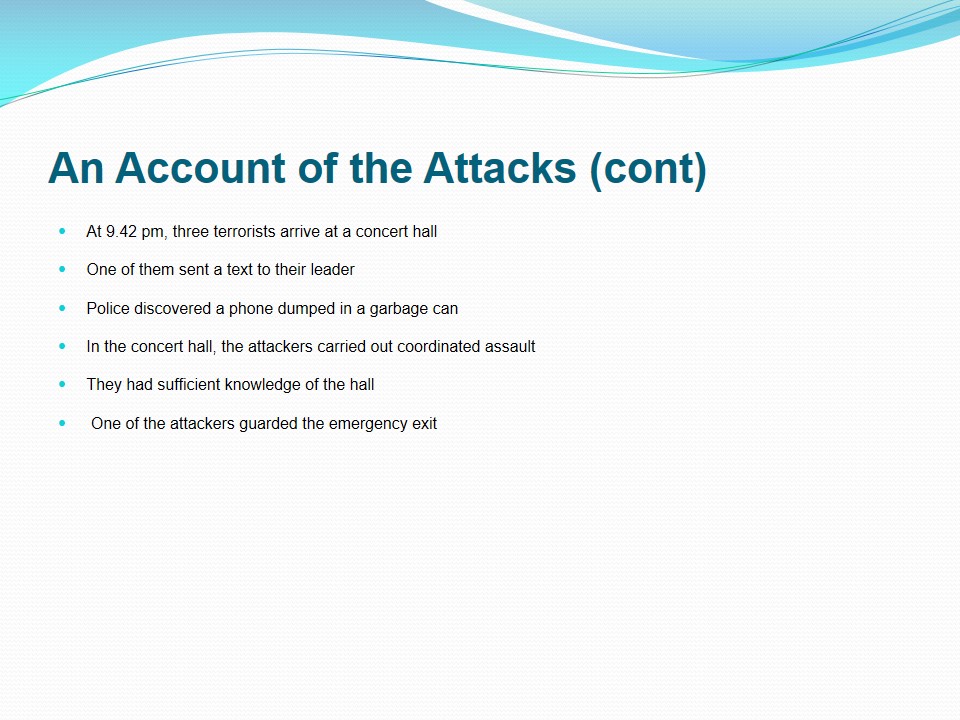
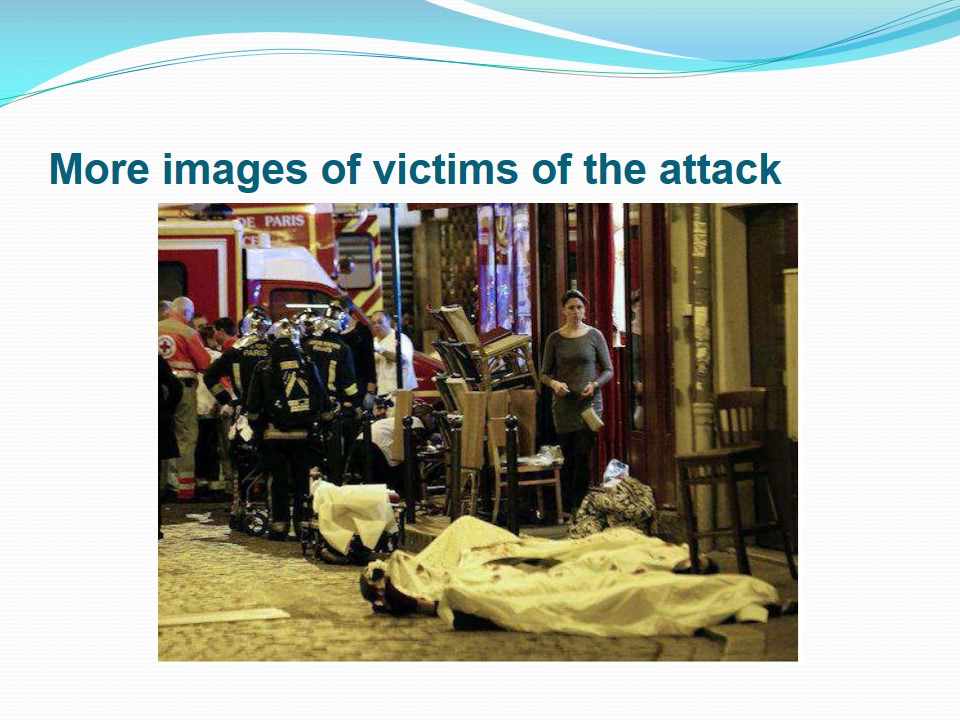
Steps to prevent the Attack
- Security experts have identified steps that could have prevented the attacks
- Efficient recognition and prioritization of threats
- Intelligence failed to monitor attackers who posed threat to the nation
- The need to share information maid European nations
- France and Belgium should have shared information regarding the whereabouts of the attackers
- Staffing and funding intelligence apparatus to improve their functions
Security experts have identified numerous measures that the French intelligence agencies could have taken to prevent the November 13, 2015 attacks. One of the steps that could have foiled the killings is effective recognition and prioritization of threats (Chrisafis). In spite of the intelligence agencies classifying some of the attackers as potentially dangerous, they failed to prioritize them, thereby not monitor their activities. Another strategy that could have prevented the attacks is sharing of information between European countries. Analysts argue that had France and Belgium shared information regarding the movement of these terrorists, it would have been difficult for them to engage in any activity without the knowledge of the law enforcement agencies (NATO Review). Allocating resources and increasing the number of intelligence officers could have also aided in effective monitoring of terror suspects (NATO Review). The French intelligence community is understaffed, making it hard for law enforcers to track all the criminals under their watch list.

Works Cited
Chrisafis, Angelique. 2016. “Paris Attacks Inquiry Finds Multiple Failings by French Intelligence Agencies.” The Guardian. Web.
Cruickshank, Paul. 2017. “The Inside Story of the Paris and Brussels Attacks.” Web.
NATO Review. “The Paris Attacks. A Case of Intelligence Failure?”. Web.